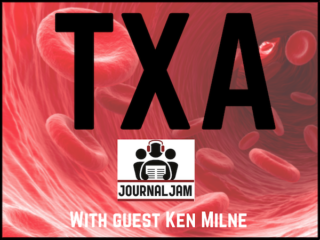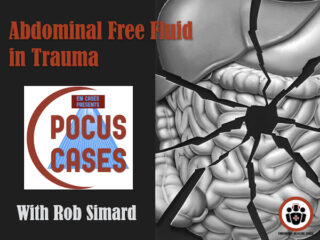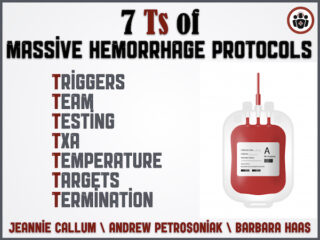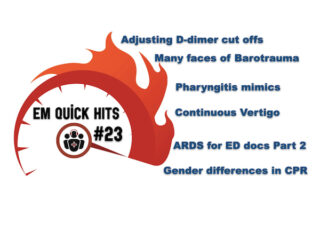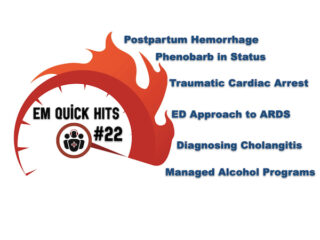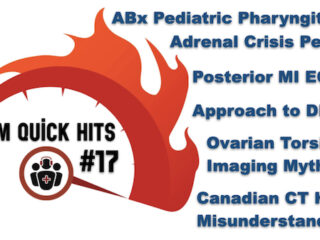Trauma
Journal Jam 18 The Evidence for TXA – Should Tranexamic Acid Be Routine Therapy in the Bleeding Patient?
With the help of a special guest, EBM guru Dr. Ken Milne of the The SGEM, Anton and Justin look at all the various potential indications for TXA and review the available evidence. Should we be using TXA for epistaxis, postpartum hemorrhage, hyphema or hemoptysis? Is it a miracle drug that stops all bleeding? Or has it been drastically overhyped? Was CRASH-2 enough to be definitive, or does the classic EBM mantra of "we need more studies" remain true?...
POCUS Cases 9 Abdominal Free Fluid in Trauma
Rob Simard explains how to incorporate abdominal POCUS into your assessment of the trauma patient, he reviews the literature on accuracy of POCUS for assessment of abdominal free fluid, reviews the key POCUS steps and cautions us about interpretation of your findings in trauma patients who have sustained an injury to their abdomen...
Ep 152 The 7 Ts of Massive Hemorrhage Protocols
Dr. Jeannie Callum, Dr. Andrew Petrosoniak and Dr. Barbara Haas join Anton in answering the questions: How do you decide when to activate the MHP? How do you know when it is safe to terminate the MHP? What lab tests need to be done, how often, and how should the results be shared with the clinical team? Once the dust settles, what do we need to tell the patient and/or their family about the consequences of being massively transfused? What should be the lab resuscitation targets? Why is serum calcium important to draw in the ED for the patient who is exsanguinating? How do we mitigate the risk of hypothermia? What can hospitals do to mitigate blood wastage? If someone is on anti-platelets or anticoagulants what is the best strategy to ensure the docs in the ED know what to give and how much? Until the results of lab testing come back and hemorrhage pace is slowed, what ratio of plasma to RBCs should we target? What's better, 1:1:1 or 2:1:1? Should we ever consider using Recombinant Factor 7a? If the fibrinogen is low, what is the optimal product and threshold for replacement? When and how much TXA? Anyone you wouldn’t give it to? and many more...
EM Quick Hits 23 – Clinical Probability Adjusted D-dimer, ARDS Part 2, Pharyngitis Mimics, Barotrauma, Vertigo, CPR Gender-Based Differences
In this month's EM Quick Hits podcast we have Salim Rezaie on clinical probability adjusted D-dimer for pulmonary embolism, Bourke Tillmann on ARDS for the ED Part 2, Brit Long & Michael Gottlieb on pharyngitis mimics, Justin Hensley on the many faces of barotrauma, Hans Rosenberg & Peter Johns on assessment of continuous vertigo and Justin Morgenstern & Jeannette Wolfe on gender-based differences in CPR...
EM Quick Hits 22 Postpartum Hemorrhage, Phenobarbital in Status Epilepticus, Managed Alcohol Programs, Traumatic Cardiac Arrest, Cholangitis, ED Approach to ARDS
In this month's EM Quick Hits podcast, Anand Swaminathan on postpartum hemorrhage, Justin Morgenstern on phenobarbital in pediatric status epilepticus, Michelle Klaiman on managed alcohol programs, Andrew Petrosoniak on traumatic cardiac arrest, Brit Long on cholangitis pearls and pitfalls and Bourke Tillman on ED approach to ARDS...
EM Quick Hits 17 Adrenal Crisis, Strep Throat, Posterior MI, DKA Just the Facts, Ovarian Torsion Imaging, HINTS Exam, Canadian CT Head Rule
Anand Swaminathan on recognition and ED management of adrenal crisis, Maria Ivankovic on indications for antibiotics in strep throat from EM Cases Course 2020, Jesse McLaren on recognition of posterior MI from ECG Cases, Justin Yan & Hans Rosenberg on just the facts of approach to DKA, Brit Long on ovarian torsion imaging myths, Walter Himmel on how to use the HINTS exam properly, and Ian Stiell on how to use Canadian CT head rules properly...

